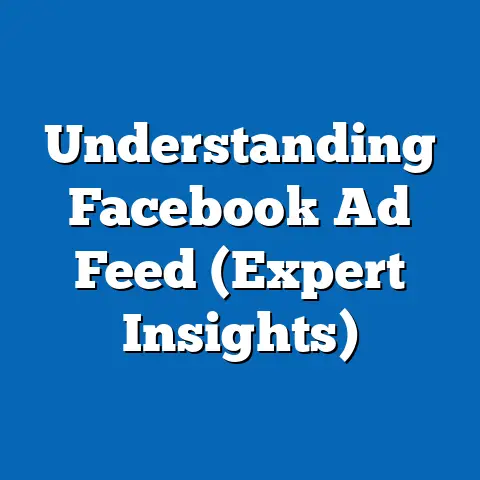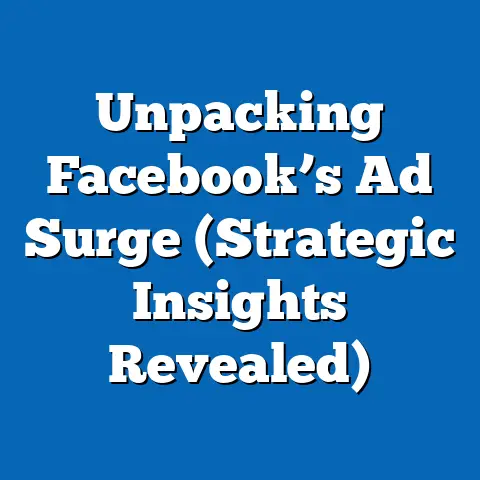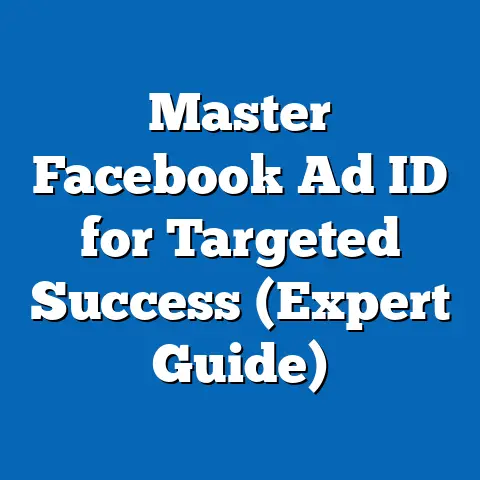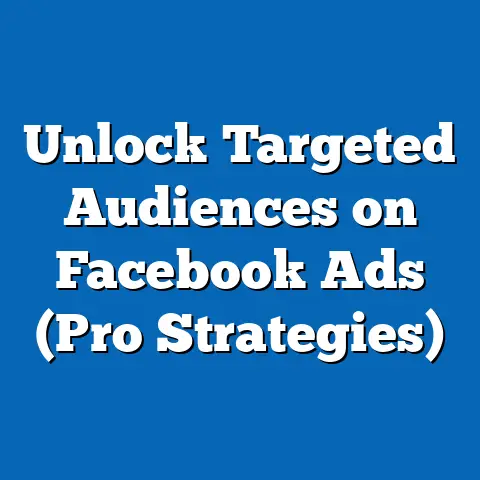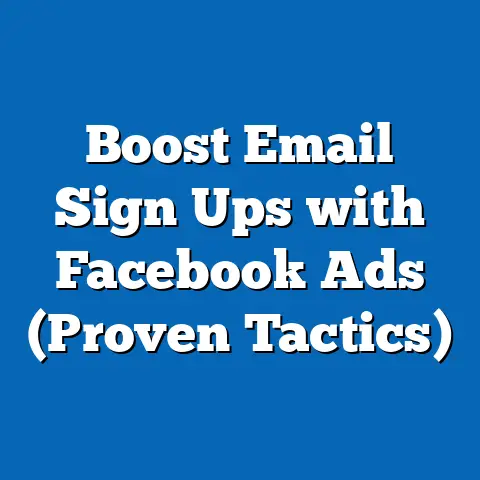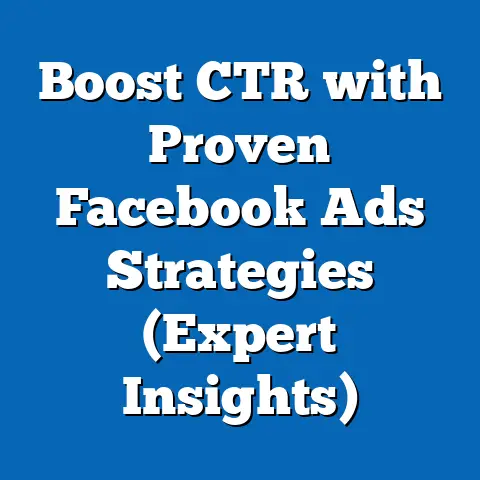Optimize Facebook Ad CTA for Higher Conversions (Pro Tips)
In the fast-paced world of Facebook advertising, where attention spans are shorter than ever, a well-crafted Call-to-Action (CTA) can be the difference between a scroll-past and a conversion. I’ve seen firsthand how a simple tweak to a CTA can send conversion rates soaring. It’s not just about throwing a “Learn More” button on your ad; it’s about understanding the psychology behind user behavior and crafting a message that compels them to take action.
Think of it this way: Facebook is a crowded marketplace, a digital bazaar where your ad is just one voice among thousands. To stand out, you need to be clear, concise, and compelling. This article is your guide to mastering the art of the CTA, providing actionable pro tips that will help you create irresistible calls to action and drive those all-important conversions on Facebook. I’ll share my own experiences, including the time I accidentally doubled a client’s lead generation simply by changing “Contact Us” to “Get a Free Quote Now!” It’s these small, strategic changes that make all the difference.
Section 1: Understanding the Role of CTAs in Facebook Ads
At its core, a Call-to-Action (CTA) is a prompt designed to encourage an immediate response or action from the viewer. In the context of Facebook advertising, it’s the button, link, or text that explicitly tells your audience what you want them to do next. This could be anything from visiting your website to making a purchase, signing up for a newsletter, or downloading a free ebook.
But a CTA is more than just a button; it’s a psychological trigger. When someone encounters your ad, their brain is subconsciously processing information, weighing the value proposition, and deciding whether to engage. A well-designed CTA taps into this process, leveraging psychological principles like:
- Reciprocity: Offering something valuable in exchange for an action (e.g., “Download our free guide”).
- Scarcity: Creating a sense of urgency by highlighting limited availability (e.g., “Limited time offer”).
- Social Proof: Showcasing positive reviews or testimonials to build trust (e.g., “Join thousands of satisfied customers”).
CTAs act as the crucial bridge connecting ad exposure to desired user actions. Without a clear and compelling CTA, your ad is like a ship without a rudder, drifting aimlessly in the sea of social media. I remember working on a campaign for a local bakery. We had beautiful images of their pastries, but the conversions were abysmal. It wasn’t until we added a “Order Now for Delivery” button that we saw a significant increase in sales.
The Impact of Effective CTAs: Data Speaks
The impact of effective CTAs on conversion rates is undeniable. Studies have shown that ads with clear and compelling CTAs can increase click-through rates (CTR) by as much as 28%. Furthermore, a study by HubSpot found that personalized CTAs convert 42% better than generic ones.
- Example: A clothing retailer ran two identical Facebook ads, one with a generic “Shop Now” CTA and another with a more specific “Shop Women’s Summer Collection.” The latter saw a 50% higher CTR and a 30% increase in sales.
Takeaway: CTAs are not an afterthought; they are a vital component of your Facebook ad strategy. Understanding their role and leveraging psychological triggers can significantly improve your ad performance.
Section 2: Crafting the Perfect CTA
Now, let’s get down to the nitty-gritty of crafting CTAs that convert. It’s not about being clever or witty; it’s about being clear, relevant, and compelling. Here are the key components:
- Clarity: Your CTA should be crystal clear about what action you want the user to take. Avoid jargon or ambiguous language. Use straightforward verbs that leave no room for interpretation.
- Example: Instead of “Discover More,” try “Learn How to…” or “Get Started Now.”
- Relevance: The CTA should directly align with the ad’s message and the target audience’s interests. If you’re advertising a discount on running shoes, your CTA should be something like “Shop Running Shoes Now” or “Get Your Discount.”
- Example: I once saw an ad for a language learning app that used the CTA “Unlock Your Potential.” While aspirational, it was too vague. A better CTA would have been “Start Learning Spanish Today” or “Download the App for Free.”
- Urgency: Create a sense of immediacy to prompt immediate action. Use time-sensitive language or highlight limited availability.
- Example: “Limited Time Offer,” “Sale Ends Soon,” “Join Before It’s Too Late.”
- Benefit-Driven Language: Highlight what users stand to gain by clicking. Focus on the value they’ll receive, whether it’s solving a problem, saving money, or gaining access to exclusive content.
- Example: Instead of “Click Here,” try “Get Your Free Ebook,” “Save 20% Today,” or “Unlock Exclusive Content.”
- Example: Instead of “Discover More,” try “Learn How to…” or “Get Started Now.”
- Example: I once saw an ad for a language learning app that used the CTA “Unlock Your Potential.” While aspirational, it was too vague. A better CTA would have been “Start Learning Spanish Today” or “Download the App for Free.”
- Example: “Limited Time Offer,” “Sale Ends Soon,” “Join Before It’s Too Late.”
- Example: Instead of “Click Here,” try “Get Your Free Ebook,” “Save 20% Today,” or “Unlock Exclusive Content.”
Strong vs. Weak CTAs: A Comparative Analysis
| Feature | Weak CTA | Strong CTA | Why It Works |
|---|---|---|---|
| Clarity | Learn More | Download Our Free Guide | Clear action, specific benefit, removes ambiguity. |
| Relevance | Click Here | Shop Women’s Summer Collection | Directly relevant to the product being advertised, targets the specific audience. |
| Urgency | Sign Up | Sign Up Now and Get 20% Off Your First Order | Creates a sense of immediacy and offers a clear incentive. |
| Benefit-Driven | Contact Us | Get a Free Quote Now! | Highlights the benefit to the user, encouraging them to take action. (This is the example I mentioned earlier!) |
| Feature | Weak CTA | Strong CTA | Why It Works |
|---|---|---|---|
| Clarity | Learn More | Download Our Free Guide | Clear action, specific benefit, removes ambiguity. |
| Relevance | Click Here | Shop Women’s Summer Collection | Directly relevant to the product being advertised, targets the specific audience. |
| Urgency | Sign Up | Sign Up Now and Get 20% Off Your First Order | Creates a sense of immediacy and offers a clear incentive. |
| Benefit-Driven | Contact Us | Get a Free Quote Now! | Highlights the benefit to the user, encouraging them to take action. (This is the example I mentioned earlier!) |
Takeaway: Crafting the perfect CTA is an art and a science. By focusing on clarity, relevance, urgency, and benefit-driven language, you can create calls to action that resonate with your audience and drive conversions.
Section 3: A/B Testing Your CTAs
You might think you’ve created the perfect CTA, but the truth is, what works for one audience might not work for another. That’s where A/B testing comes in. A/B testing (also known as split testing) is the process of comparing two versions of your CTA to see which one performs better. It’s a data-driven way to optimize your CTAs for higher conversions.
Here’s how to set up A/B tests for different CTA variations on Facebook:
- Identify the Variable: Choose one element of your CTA to test. This could be the wording, button color, size, or placement.
- Create Two Versions: Create two versions of your ad, each with a different variation of the CTA you’re testing.
- Set Up Your Campaign: In Facebook Ads Manager, create a new campaign and choose the “Conversions” objective.
- Create an Ad Set: Within your ad set, enable the “Dynamic Creative” feature. This allows Facebook to automatically test different combinations of your ad creative, including your CTAs.
- Upload Your Ads: Upload both versions of your ad, ensuring that the only difference is the CTA you’re testing.
- Set Your Budget and Schedule: Set your budget and schedule for the A/B test. I recommend running the test for at least a week to gather enough data.
- Analyze the Results: Once the test is complete, analyze the results in Facebook Ads Manager. Look at metrics like CTR, conversion rate, and cost per conversion to determine which CTA performed better.
What to Test:
- Wording: Test different verbs and phrases to see which resonates most with your audience (e.g., “Sign Up Now” vs. “Join Today”).
- Button Colors and Sizes: Experiment with different colors and sizes to see which draws the most attention.
- Placement: Test different placements within the ad (above the fold, within the text, at the end of the ad) to see which drives the most clicks.
Interpreting Results and Making Data-Driven Decisions:
Don’t just blindly follow the data; understand why one CTA performed better than the other. Was it the wording? The color? The placement? Use these insights to inform your future ad campaigns.
- Example: You run an A/B test and find that the “Download Now” CTA outperformed the “Learn More” CTA. This suggests that your audience is more interested in taking immediate action than simply learning about your product. Use this information to create more direct and action-oriented CTAs in the future.
Takeaway: A/B testing is essential for optimizing your CTAs. By systematically testing different variations and analyzing the results, you can make data-driven decisions that improve your ad performance.
Section 4: Visual Elements and CTA Placement
Visual elements play a crucial role in enhancing CTA effectiveness. A visually appealing ad will naturally draw the eye, increasing the likelihood that users will notice and engage with your CTA.
Designing Eye-Catching Buttons and Graphics:
- Color: Use contrasting colors that make your CTA stand out from the rest of the ad.
- Size: Make sure your CTA is large enough to be easily seen, but not so large that it overwhelms the ad.
- Shape: Experiment with different shapes to see which performs best. Rounded buttons tend to be more visually appealing than square ones.
- Font: Use a clear and legible font that is easy to read.
I’ve found that adding a subtle shadow or glow effect to the CTA button can also make it pop. It’s the little details that often make the biggest difference.
The Impact of CTA Placement:
Where you place your CTA within the ad can also have a significant impact on user engagement. Here are some best practices:
- Above the Fold: Placing your CTA above the fold (the area of the ad that is visible without scrolling) ensures that users see it immediately.
- Within the Text: Integrating your CTA seamlessly into the ad copy can make it feel more natural and less intrusive.
- At the End of the Ad: Placing your CTA at the end of the ad provides users with all the information they need before taking action.
Balancing Text and Visuals:
The key is to strike a balance between text and visuals. Your CTA should stand out without overwhelming the ad. Avoid cluttering the ad with too much text or too many visual elements.
Takeaway: Visual elements and CTA placement are critical factors in driving user engagement. By designing eye-catching buttons and graphics and strategically placing your CTA within the ad, you can significantly improve your ad performance.
Section 5: Real-World Examples of Effective CTAs
Let’s take a look at some real-world examples of Facebook ads that feature standout CTAs:
- Example 1: Dollar Shave Club
- Visual: A humorous video showcasing the benefits of their razor subscription service.
- CTA: “Get Started”
- Why It Works: The CTA is simple, direct, and aligns perfectly with the ad’s message. The video grabs attention, and the “Get Started” button makes it easy for users to sign up.
- Example 2: Skillshare
- Visual: A visually appealing image showcasing a variety of online courses.
- CTA: “Start Learning”
- Why It Works: The CTA is benefit-driven and speaks directly to the target audience’s desire to learn new skills.
- Example 3: Airbnb
- Visual: A stunning photo of a unique Airbnb property.
- CTA: “Book Now”
- Why It Works: The CTA is clear, concise, and creates a sense of urgency. The beautiful photo inspires users to book their next vacation.
- Visual: A humorous video showcasing the benefits of their razor subscription service.
- CTA: “Get Started”
- Why It Works: The CTA is simple, direct, and aligns perfectly with the ad’s message. The video grabs attention, and the “Get Started” button makes it easy for users to sign up.
- Visual: A visually appealing image showcasing a variety of online courses.
- CTA: “Start Learning”
- Why It Works: The CTA is benefit-driven and speaks directly to the target audience’s desire to learn new skills.
- Visual: A stunning photo of a unique Airbnb property.
- CTA: “Book Now”
- Why It Works: The CTA is clear, concise, and creates a sense of urgency. The beautiful photo inspires users to book their next vacation.
Lessons Learned:
- Keep it simple: The most effective CTAs are often the simplest.
- Align with your brand: Your CTA should reflect your brand’s voice and personality.
- Test, test, test: Don’t be afraid to experiment with different CTAs to see what works best for your audience.
Takeaway: By studying successful Facebook ads and analyzing the elements that make their CTAs effective, you can gain valuable insights that you can apply to your own campaigns.
Conclusion
Optimizing your Facebook ad CTAs for higher conversions is an ongoing process. It requires a deep understanding of your audience, a willingness to experiment, and a commitment to data-driven decision-making. By focusing on simplicity, clarity, relevance, and visual appeal, you can create CTAs that resonate with your audience and drive the results you’re looking for.
Remember to always A/B test your CTAs, analyze the results, and make adjustments based on the data. And don’t be afraid to get creative and try new things. The world of Facebook advertising is constantly evolving, so it’s important to stay ahead of the curve.
So, go forth and craft CTAs that convert! Your Facebook ad success depends on it. And who knows, maybe you’ll stumble upon a simple tweak that doubles your lead generation, just like I did with that bakery client. It’s all about paying attention to the details and understanding the power of a well-crafted Call-to-Action.

